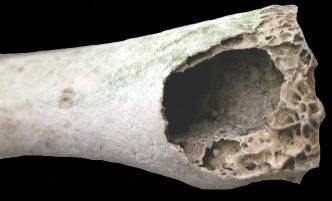
When I was a kid I would try to fly by holding my jacket open on windy days. This didn’t work because I was too heavy and my “wings” were too short for the wind to lift me.
Weight is clearly a disadvantage if you want to fly. The more you weigh the bigger your wings have to be and, as we learned in 2009, there is a limit to how big you can be and still replace your flight feathers in a reasonable amount of time.
To adapt for flight, birds lightened their skeletons by evolving hollow bones. This sounds fragile but the bones are strong because they are braced internally by tiny trusses. You can see these trusses as a network inside the outer edge of the bone pictured above or click here to see a drawing that shows how engineers borrowed this structure to strengthen bridges.
Not all birds have hollows bones. Loons, for example, dive deep underwater for their food. For them buoyancy (air inside hollow bones) would be a disadvantage, so their bones are solid.
(photo of a bird’s hollow bone linked from Renn Tumlison’s Nature Trivia at Henderson State University. Click the photo to see the original and Dr. Tumlinson’s description of hollow bones.)
original was at www.hsu.edu/uploadedImages/Biology/hollow%20bone.jpg
I have a question Kate. Because some bird’s have hollow bones, is it a help or a hinderence if they fly into a window.
Do the hollow bones make it less of a impact?
Karen, I’m not sure that it matters. If we humans flew head first into windows we’d have concussions or broken necks.